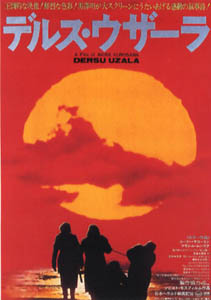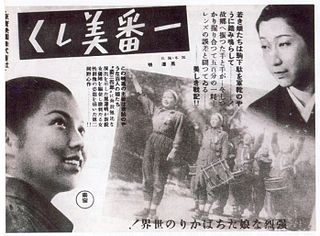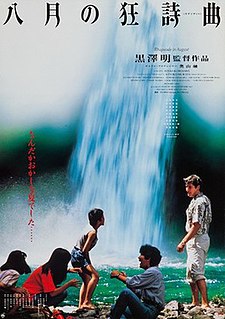 W
WThe Bad Sleep Well is a 1960 Japanese crime mystery film directed by Akira Kurosawa. It was the first film to be produced under Kurosawa's own independent production company. It was entered into the 11th Berlin International Film Festival.
 W
WDersu Uzala is a 1975 Soviet-Japanese film directed by Akira Kurosawa, his only non-Japanese-language film and his only 70mm film.
 W
WDodes'ka-den is a 1970 Japanese film directed by Akira Kurosawa, based on a book by Shūgorō Yamamoto. It was Kurosawa's first film in color.
 W
WDreams is a 1990 magical realist film of eight vignettes written and directed by Akira Kurosawa. It was inspired by actual dreams that Kurosawa claimed to have had repeatedly. It was his first film in 45 years in which he was the sole author of the screenplay. An international co-production of Japan and Worldwide, Dreams was made five years after Ran, with assistance from George Lucas and Steven Spielberg, and funded by Warner Bros. The film was screened out of competition at the 1990 Cannes Film Festival, and has consistently received positive reviews.
 W
WDrunken Angel is a 1948 Japanese yakuza film directed by Akira Kurosawa. It is notable for being the first of sixteen film collaborations between director Kurosawa and actor Toshiro Mifune.
 W
WThe Hidden Fortress is a 1958 jidaigeki adventure film directed by Akira Kurosawa. It tells the story of two peasants who agree to escort a man and a woman across enemy lines in return for gold without knowing that he is a general and the woman is a princess. The film stars Toshiro Mifune as General Makabe Rokurōta and Misa Uehara as Princess Yuki while the role of the peasants, Tahei and Matashichi, are portrayed by Minoru Chiaki and Kamatari Fujiwara respectively.
 W
WHigh and Low is a 1963 police procedural crime film directed by Akira Kurosawa, starring Toshiro Mifune, Tatsuya Nakadai and Kyōko Kagawa. The film is loosely based on the 1959 novel King's Ransom by Ed McBain.
 W
WUma is a 1941 black-and-white Japanese film directed by Kajiro Yamamoto and starring Hideko Takamine, whom Yamamoto had directed in his film Composition Class three years before. Uma was actually completed by assistant director Akira Kurosawa. It follows the story of Ine Onoda, the eldest daughter of a poor family of farmers, who raises a colt from birth and comes to love the horse dearly. When the horse is grown, the government orders it auctioned and sold to the army. Ine struggles to prevent the sale.
 W
WI Live In Fear is a 1955 Japanese drama film directed by Akira Kurosawa, produced by Sōjirō Motoki, and written by Kurosawa with Shinobu Hashimoto, Fumio Hayasaka, and Hideo Oguni. The film stars Toshiro Mifune as an elderly factory owner so terrified of the prospect of a nuclear attack that he becomes determined to move his entire extended family to what he imagines is the safety of a farm in Brazil.
 W
WThe Idiot is a 1951 Japanese film directed by Akira Kurosawa. It is based on the 1869 novel The Idiot by Fyodor Dostoevsky. The original 265-minute version of the film, faithful to the novel, has been lost for many years. A nearly three-hour release, reflecting a 100-minute studio-imposed cut, survives as the most complete version of the film available for contemporary audiences.
 W
WIkiru is a 1952 Japanese drama film directed and co-written by Akira Kurosawa and starring Takashi Shimura. The film examines the struggles of a terminally ill Tokyo bureaucrat and his final quest for meaning. The screenplay was partly inspired by Leo Tolstoy's 1886 novella The Death of Ivan Ilyich.
 W
WKagemusha is a 1980 jidaigeki film directed by Akira Kurosawa. Kagemusha is the Japanese term for a political decoy, literally meaning "shadow warrior". It is set in the Sengoku period of Japanese history and tells the story of a lower-class criminal who is taught to impersonate a dying daimyō to dissuade opposing lords from attacking the newly vulnerable clan. The daimyō is based on Takeda Shingen, and the film ends with the climactic 1575 Battle of Nagashino.
 W
WThe Lower Depths is a 1957 Japanese film directed by Akira Kurosawa, based on the 1902 play The Lower Depths by Maxim Gorky. The setting was changed for the film from late 19th-century Russia to Edo period Japan.
 W
WMadadayo is a 1993 Japanese comedy-drama film. It is the thirtieth and final film to be completed by Akira Kurosawa. It was screened out of competition at the 1993 Cannes Film Festival. The film was selected as the Japanese entry for the Best Foreign Language Film at the 66th Academy Awards, but was not accepted as a nominee.
 W
WThe Men Who Tread on the Tiger's Tail is a 1945 Japanese period drama film, written and directed by Akira Kurosawa. It is based on the kabuki play Kanjinchō, which is in turn based on the Noh play Ataka.
 W
WThe Most Beautiful is a 1944 Japanese drama and propaganda film written and directed by Akira Kurosawa. The film is set in an optics factory during the Second World War when the film was produced.
 W
WNo Regrets for Our Youth is a 1946 film written and directed by Akira Kurosawa. It is based on the 1933 Takigawa incident.
 W
WOne Wonderful Sunday is a 1947 Japanese film co-written and directed by Akira Kurosawa. It is in black-and-white and runs 108 minutes. The film was made during the allied occupation of Japan and shows some of the challenges being faced by post-war Tokyo. It is notable in the Kurosawa canon because Masako breaks the fourth wall near the end of the film.
 W
WThe Quiet Duel is a 1949 Japanese film directed by Akira Kurosawa.
 W
WRan is a 1985 epic action drama film directed, edited and co-written by Akira Kurosawa. The plot derives from William Shakespeare's King Lear and includes segments based on legends of the daimyō Mōri Motonari. The film stars Tatsuya Nakadai as Hidetora Ichimonji, an aging Sengoku-period warlord who decides to abdicate as ruler in favor of his three sons.
 W
WRashomon is a 1950 Jidaigeki psychological thriller/crime film directed by Akira Kurosawa, working in close collaboration with cinematographer Kazuo Miyagawa. Starring Toshiro Mifune, Machiko Kyō, Masayuki Mori, and Takashi Shimura as various people who describe how a samurai was murdered in a forest, the plot and characters are based upon Ryunosuke Akutagawa’s short story "In a Grove", with the title and framing story being based on "Rashōmon", another short story by Akutagawa. Every element is largely identical, from the murdered samurai speaking through a Shinto psychic to the bandit in the forest, the monk, the rape of the wife, and the dishonest retelling of the events in which everyone shows his or her ideal self by lying.
 W
WRed Beard is a 1965 Japanese film directed by Akira Kurosawa about the relationship between a town doctor and his new trainee. It takes place in Koishikawa, a district of Edo, towards the end of the Tokugawa period. The film was based on Shūgorō Yamamoto's 1959 short story collection, Akahige Shinryōtan (赤ひげ診療譚). Fyodor Dostoevsky's novel Humiliated and Insulted provided the source for a subplot about a young girl, Otoyo, who is rescued from a brothel.
 W
WRhapsody in August is a 1991 Japanese film by Akira Kurosawa based on the novel Nabe no naka by Kiyoko Murata. The story centers on an elderly hibakusha, who lost her husband in the 1945 atomic bombing of Nagasaki, caring for her four grandchildren over the summer. She learns of a long-lost brother, Suzujiro, living in Hawaii who wants her to visit him before he dies. American film star Richard Gere appears as Suzujiro's son Clark. The film was selected as the Japanese entry for the Best Foreign Language Film at the 64th Academy Awards, but was not accepted as a nominee.
 W
WSanjuro is a 1962 black-and-white Japanese jidaigeki film directed by Akira Kurosawa and starring Toshiro Mifune. It is a sequel to Kurosawa's 1961 Yojimbo.
 W
WSanshiro Sugata is a 1943 Japanese martial arts drama film and the directorial debut of the Japanese film director Akira Kurosawa. First released in Japan on 25 March 1943 by Toho film studios, the film was eventually released in the United States on 28 April 1974. The film is based on the novel of the same name written by Tsuneo Tomita, the son of prominent judoka Tsunejirō Tomita. It follows the story of Sanshiro, a talented though willful youth, who travels to the city in order to learn Jujutsu. However, upon his arrival he discovers a new form of self-defence: Judo. The main character is based on Saigō Shirō.
 W
WSanshiro Sugata Part II is a 1945 Japanese action drama film written and directed by Akira Kurosawa. It is based on the novel by Tsuneo Tomita, son of Tomita Tsunejirō, the earliest disciple of judo. It was filmed in early 1945 in Japan towards the end of World War II. Unlike the original Sugata Sanshiro, the sequel is in part considered a propaganda film.
 W
WScandal is a 1950 film written and directed by Akira Kurosawa. The film stars Toshirō Mifune, Takashi Shimura and Shirley Yamaguchi.
 W
WSeven Samurai is a 1954 Japanese epic samurai drama film co-written, edited, and directed by Akira Kurosawa. The story takes place in 1586 during the Sengoku period of Japanese history. It follows the story of a village of desperate farmers who hire seven rōnin to combat bandits who will return after the harvest to steal their crops.
 W
WStray Dog is a 1949 Japanese film noir crime drama directed by Akira Kurosawa and starring Toshiro Mifune and Takashi Shimura. It was Kurosawa's second film of 1949 produced by the Film Art Association and released by Shintoho. It is also considered a detective movie that explores the mood of Japan during its painful postwar recovery. The film is also considered a precursor to the contemporary police procedural and buddy cop film genres, based on its premise of pairing two cops with different personalities and motivations together on a difficult case.
 W
WThrone of Blood is a 1957 Japanese historical drama film co-written and directed by Akira Kurosawa, with special effects by Eiji Tsuburaya. The film transposes the plot of William Shakespeare's play Macbeth from Medieval Scotland to feudal Japan, with stylistic elements drawn from Noh drama. The film stars Toshiro Mifune and Isuzu Yamada in the lead roles, modelled on the characters Macbeth and Lady Macbeth.
 W
WYojimbo is a 1961 Japanese samurai film directed by Akira Kurosawa, who produced the film with Tomoyuki Tanaka and Ryūzō Kikushima. Kurosawa wrote the screenplay with Kikushima and Hideo Oguni based on Kurosawa's story. Kurosawa also edited the film. It tells the story of a rōnin, portrayed by Toshiro Mifune, who arrives in a small town where competing crime lords vie for supremacy. The two bosses each try to hire the newcomer as a bodyguard.